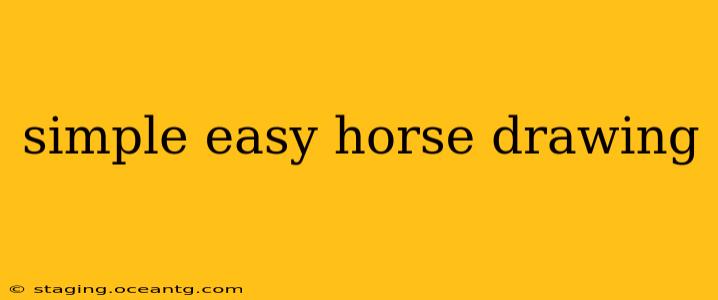Learning to draw a horse can seem daunting, but with a few simple steps and the right techniques, even beginners can create beautiful and recognizable horse drawings. This guide will walk you through several easy methods, perfect for kids and adults alike. We'll cover different styles, from cartoonish horses to more realistic representations, ensuring there's something for everyone.
How to Draw a Simple Cartoon Horse
This method is ideal for beginners and children. We'll focus on basic shapes to create a cute and easily recognizable horse.
- The Body: Start with a large oval shape for the horse's body.
- The Head: Add a smaller circle slightly overlapping the oval for the head.
- The Legs: Draw four simple, slightly curved lines extending down from the body to represent the legs. Keep them relatively straight for a simplified look.
- The Neck: Connect the head and body with a curved line forming the neck.
- The Mane and Tail: Add a simple, flowing line for the mane on the top of the head and a similar line for the tail at the back of the body.
- The Ears: Draw two small triangles on top of the head for the ears.
- The Eyes: Add two small circles or ovals for the eyes. A simple smile can complete the friendly look.
You can now erase any unnecessary guiding lines and add details like hooves or a saddle if desired. Experiment with different shapes and sizes to create your unique cartoon horse!
How to Draw a Simple Realistic Horse (Simplified)
This approach focuses on creating a more realistic-looking horse, but still keeps it simple enough for beginners.
- The Head: Begin with a slightly elongated oval for the head. This time, the oval is not perfectly symmetrical – it’s slightly wider at the bottom.
- The Muzzle: Add a smaller, slightly pointed oval at the bottom of the larger oval for the muzzle.
- The Neck and Body: Draw a curved line connecting the head to a larger, somewhat elongated oval representing the body. This oval is wider at the front and tapers slightly towards the rear.
- The Legs: Similar to the cartoon horse, draw four slightly curved lines for the legs, but this time, try to make them slightly more tapered towards the hooves.
- The Mane and Tail: Create more detailed manes and tails than in the cartoon version. Use flowing, slightly wavy lines to suggest movement and texture.
- The Ears: Add two more defined triangular ears.
- The Details: Add smaller details like the eyes (using oval shapes), nostrils, and a mouth. Consider adding a slight curve to the spine to imply movement.
Remember to use light pencil strokes initially so you can easily erase and adjust as you go. Focus on the overall proportions and shapes before adding fine details.
What are some easy horse drawing tutorials for kids?
Numerous online resources offer step-by-step tutorials specifically designed for children. Search for "easy horse drawing for kids" on YouTube or other educational websites. These tutorials often utilize simpler shapes and methods, making them ideal for younger learners. Many break down the drawing process into manageable, easy-to-follow steps, often incorporating fun elements to keep children engaged.
What supplies do I need to draw a horse?
You don't need expensive supplies to begin. A standard HB pencil is sufficient for sketching. You might also want a softer pencil (like a 2B or 4B) for shading and adding darker details. An eraser is essential for correcting mistakes, and a sheet of paper completes your basic drawing kit. For more advanced techniques, you can add colored pencils, crayons, or markers.
Can I trace a horse drawing to learn?
Tracing is a good way to understand proportions and shapes, but it's important to use tracing as a learning tool, not a shortcut to avoid learning the actual drawing process. Trace a picture, then try drawing it from memory or by looking at a reference image. This will help solidify your understanding of the horse's anatomy and build your drawing skills.
This guide provides a starting point for drawing horses. Remember, practice is key. The more you draw, the better you'll become at capturing the essence and movement of these magnificent animals. Don't be afraid to experiment, try different styles, and most importantly, have fun!
